November 17 – November 23: 22 Weeks 0 Days – 22 Weeks 6 Days.
Bu(m)pdate for this rainy week:
I’ve officially burnt out of reading books about pregnancy and childbirth, and am now moving on to reading about newborn care. Here’s what I thought of the books I read:
Natural Hospital Birth: The Best of Both Worlds by Cynthia Gabriel
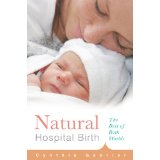 This was my favorite book I read about childbirth because it’s well-written, non-repetitive, and focuses on exactly the type of birth I’m planning to have. I did my research and have chosen to give birth in a hospital, so it’s tiresome to read books and articles about natural birth that push me to do it at home; home birth is a great option with several benefits, but it’s not the option I chose. Natural Hospital Birth clearly and concisely lays out birth options, and offers written exercises to help the reader make good guesses about what they’ll want during labor and childbirth. (Several weeks ago, I blogged about some realizations I had while reading this book). After reading this book I felt much better educated about my choices and I felt prepared to navigate having as natural a birth as possible in a hospital setting.
This was my favorite book I read about childbirth because it’s well-written, non-repetitive, and focuses on exactly the type of birth I’m planning to have. I did my research and have chosen to give birth in a hospital, so it’s tiresome to read books and articles about natural birth that push me to do it at home; home birth is a great option with several benefits, but it’s not the option I chose. Natural Hospital Birth clearly and concisely lays out birth options, and offers written exercises to help the reader make good guesses about what they’ll want during labor and childbirth. (Several weeks ago, I blogged about some realizations I had while reading this book). After reading this book I felt much better educated about my choices and I felt prepared to navigate having as natural a birth as possible in a hospital setting.
Ina May’s Guide to Childbirth by Ina May Gaskin
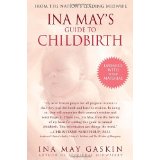 I read this book years before I got pregnant for my prenantal yoga teacher training. The first half is full of empowering natural birth stories, and the second half is a detailed explanation of labor and birth, and evidence-based information about what helps and what hurts (different birth positions, medications, interventions). Before reading this book, I didn’t really get why anyone would go through the ordeal of having a natural birth. After reading it, I concluded that my baby and I would have the best chances at a good outcome having as natural a birth as possible (leaving room for medically necessary interventions, of course).
I read this book years before I got pregnant for my prenantal yoga teacher training. The first half is full of empowering natural birth stories, and the second half is a detailed explanation of labor and birth, and evidence-based information about what helps and what hurts (different birth positions, medications, interventions). Before reading this book, I didn’t really get why anyone would go through the ordeal of having a natural birth. After reading it, I concluded that my baby and I would have the best chances at a good outcome having as natural a birth as possible (leaving room for medically necessary interventions, of course).
However, the book has such a strong agenda toward promoting natural home birth, that I felt some interventions are presented in a overly negative light. For example, after reading the chapter “What You Least Expect When You’re Expecting,” I felt scared of pitocin (a drug that stimulates labor) because of the potential side effects, but that fear is not going to serve me if pitocin ends up being medically necessary for me.
Also, in the years since this book was written many hospitals have shifted away from the dismal scene Ina May presents: a fluorescent-lit room where you’re strapped down on your back, denied food and drink, and cut open (via C-section of episiotomy) so the doctor can yank the baby out of you. At my hospital (Saint Luke’s in San Francisco) the labor and delivery rooms are dimly lit, you’re allowed to give birth in any position (they provide a squatting bar, birthing ball, and birthing chair), they let you eat and drink (unless you’re getting an epidural or C-section), they don’t do routine episiotomies, and they recommend hiring a doula. Despite these qualms, overall this book is amazing. I’m planning to reread the birth stories a my baby’s birth nears.
Having Faith by Sandra Steingraber
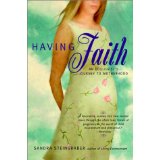 This book incorporates elements of memoir and informational non-fiction. This format makes it slower to read and harder to reference if you’re looking for a specific piece of information, but I enjoyed it anyway. The book is a detailed discussion about how what we eat, drink, breathe, and touch can affect babies’ development during pregnancy and breastfeeding. With my dry background in science, the author’s vibrant, metaphor-rich descriptions of embryonic development were refreshing. I found the detailed information about various environmental teratogens (substances that can cause birth defects) fascinating. This book inspired me to take the risk of heavy metals more seriously—lead and mercury can be devastating for a baby’s brain development. One caveat: Many of the harmful conditions that can affect the baby’s development can’t be changed easily or immediately, so some of the take-aways may be a little depressing (unless you have time to become an environmental activist, elicit a change in governmental regulations, and wait for the benefits to take effect before you get pregnant).
This book incorporates elements of memoir and informational non-fiction. This format makes it slower to read and harder to reference if you’re looking for a specific piece of information, but I enjoyed it anyway. The book is a detailed discussion about how what we eat, drink, breathe, and touch can affect babies’ development during pregnancy and breastfeeding. With my dry background in science, the author’s vibrant, metaphor-rich descriptions of embryonic development were refreshing. I found the detailed information about various environmental teratogens (substances that can cause birth defects) fascinating. This book inspired me to take the risk of heavy metals more seriously—lead and mercury can be devastating for a baby’s brain development. One caveat: Many of the harmful conditions that can affect the baby’s development can’t be changed easily or immediately, so some of the take-aways may be a little depressing (unless you have time to become an environmental activist, elicit a change in governmental regulations, and wait for the benefits to take effect before you get pregnant).
Other resources I used:
The Business of Being Born Documentary
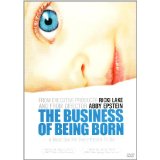 If you’re okay with shaking your trust in the medical system, watch this documentary. The track record of medical interventions in normal births over last 100+ years has been kind of horrifying (for an example, read up on Twilight Sleep). It will also give you a window into the types of things you’ll read about in much more detail in Ina May’s Guide to Childbirth. Side benefit: Rikki Lake is the interviewer, which is a fun blast from the past.
If you’re okay with shaking your trust in the medical system, watch this documentary. The track record of medical interventions in normal births over last 100+ years has been kind of horrifying (for an example, read up on Twilight Sleep). It will also give you a window into the types of things you’ll read about in much more detail in Ina May’s Guide to Childbirth. Side benefit: Rikki Lake is the interviewer, which is a fun blast from the past.
Hypnobabies® Home Study Course
This was recommended to me by a few different friends, and there are several things I enjoy about it:
- The track of joyful pregnancy affirmations (psychological factors have a huge effect on how women experience pain during labor, so positivity throughout pregnancy is key).
- Positive rewording. In Hypnobabies, “labor” is called “my birthing time” so it doesn’t sound as hard), “contractions” are called “pressure waves” (which sounds more positive and productive), and the “due date” is called the “guess date” (so the baby isn’t considered “late” if it’s born after that). I’m all for anything that makes my perception of pregnancy and childbirth positive.
- The recorded self-hypnosis sessions. Due to issues with my hypermobile joints, I haven’t been able to practice much yoga during pregnancy (so poses, anyway), so these tracks have been like my meditation. They are each 30 minutes long, which drives me crazy on fidgety days, but practicing everyday has helped me refine my ability to completely relax. Some of the tracks include visualizations that helped me connect with my baby before she starting kicking and feeling real.
The overall course is pretty time-consuming. If you do everything the manual says, you’ll spend over an hour a day on it for six weeks (and, of course, the course author says that if you don’t do everything they tell you to it wont work for you). I started my course early, and am going through it much slower than recommended.
Beyond the instructions on self-hypnosis, I’m not a fan of the content in the manual for the course. The dialog in the manual also seems to implicitly blame the mother if the Hypnobabies techniques don’t work for her (i.e. it must have been because the mother wasn’t dedicated enough in her preparation). It’s also got pretty single-track education about childbirth, which made me feel like if my birth went any differently than that one ideal way, all the techniques I’d learned would no longer apply. I want to feel positive, prepared, and accepting no matter what happens.
There were some nuggets of wonderful information in the manual, so it was worth reading for me. However, despite what the author writes (that Hypnobabies should be your only childbirth education course lest the other courses sully your positivity), I would recommend that you read more than only the Hypnobabies® manual to prepare for childbirth. Maybe doing just that will water down the effectiveness of the techniques for me, but that’s okay—I’m not attached to having a brand name childbirth.
BabyCenter My Pregnancy Today App
This is a fun app to have to keep track of what week I’m in, what the baby is up to, how I can alleviate discomforts, and how I can prepare for what’s to come. BabyCenter’s write-ups compare the baby to a fruit or vegetable every week, which is cute (but can also be confusing: A carrot? Like how big of a carrot?). I mostly enjoy checking this app, but sometimes I feel like it can be an overload of information that isn’t easily verified. For example, this article about herbal tea during pregnancy made me worry about drinking herbal infusions my doctors said were fine (like chamomile tea). The article has no citations so it would take a ton of independent research to assess the quality of all the information. After doing some half-hearted research on my own, I decided to stop stressing about it and drink my favorite herbal teas in moderation.
What Richard read:
The Birth Partner by Penny Simkin
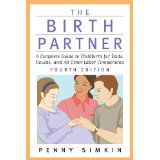 A friend who had a baby about a year ago recommended this book. I can’t give much of a review on it, because I didn’t read it, Richard did. From my perspective, reading the book made Richard feel more comfortable and confident about supporting me during childbirth. Some days he’d come home after reading his book on the bus and ask if I needed him to make me a snack or anything. He’d explain that the book had reminded him to take care of me in any way that I needed it. It’s a tough read though. Even though Richard is a fast reader, it took him a while to get through. He also didn’t like reading the sections about complications—I felt the same way in all the books I read—but if any of that stuff does end up happening, at least we’ll be informed about what’s going on.
A friend who had a baby about a year ago recommended this book. I can’t give much of a review on it, because I didn’t read it, Richard did. From my perspective, reading the book made Richard feel more comfortable and confident about supporting me during childbirth. Some days he’d come home after reading his book on the bus and ask if I needed him to make me a snack or anything. He’d explain that the book had reminded him to take care of me in any way that I needed it. It’s a tough read though. Even though Richard is a fast reader, it took him a while to get through. He also didn’t like reading the sections about complications—I felt the same way in all the books I read—but if any of that stuff does end up happening, at least we’ll be informed about what’s going on.
The Missing Pieces:
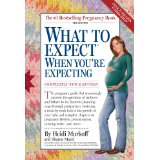 Between my prenatal yoga teacher training, the reading material the hospital gave me, and a human growth and development course I took during university, I had solid understanding about how babies develop and the discomforts I would face during pregnancy, however none of books listed above covers these topics in depth. Also, all of the books I read went over the medical aspects of childbirth in some way, but none covered the medical aspects of pregnancy. I didn’t have a book that explained what to expect at my first prenatal appointment, what my prenatal screening options were, or when I would be getting ultrasounds. A midwife I know recommended against reading the mainstream bible on pregnancy, What to Expect When You’re Expecting, because it apparently uses language that’s disempowering to women and pathologizes pregnancy and childbirth. Even so, since I’m going the hospital route, I think it would have been nice to read an overview book like this early on so I knew, for example, that the transvaginal ultrasound was coming in my first prenatal visit (I didn’t even know that thing existed!).
Between my prenatal yoga teacher training, the reading material the hospital gave me, and a human growth and development course I took during university, I had solid understanding about how babies develop and the discomforts I would face during pregnancy, however none of books listed above covers these topics in depth. Also, all of the books I read went over the medical aspects of childbirth in some way, but none covered the medical aspects of pregnancy. I didn’t have a book that explained what to expect at my first prenatal appointment, what my prenatal screening options were, or when I would be getting ultrasounds. A midwife I know recommended against reading the mainstream bible on pregnancy, What to Expect When You’re Expecting, because it apparently uses language that’s disempowering to women and pathologizes pregnancy and childbirth. Even so, since I’m going the hospital route, I think it would have been nice to read an overview book like this early on so I knew, for example, that the transvaginal ultrasound was coming in my first prenatal visit (I didn’t even know that thing existed!).
Next in my queue:
Baby 411 by Ari Brown and Denise Fields. (I’ve already started this, and it is slow going).
The Baby Book by the entire Sears family, I think. (I’ve tasked Richard with reading this one)
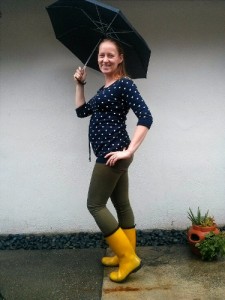
Pingback: 23 Weeks Pregnant: To Work or Not To Work? | barbie levasseur